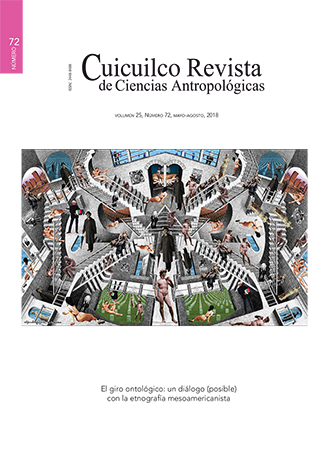Consaguinize and deconsanguinize, Tepehuas ways to "replace": to make consanguineous ties between new parents and new children, new grandparents and new grandchildren. But also consanguineous in-law?
Published 2019-02-08
Keywords
- Tepehua, Ma'alh'amá ', kinship, consanguinize, desconsanguinize, shamanic rites
How to Cite
Abstract
This article describes the shamanic ritual practices that allow the Ma'alh'amanin (Eastern Tepehuas) to break the old bonds of consanguinity with parents who have died, or are absent in life, and build new consanguineous ties with the "replacements" (oqxtapáaxanín) that substitute them as ‘new’ parents, whereby the main purpose of the article is to propose that, according to ethnographic data, consanguineous relations are not a universal biological fact, but rather a social-ontological construction. The article also places emphasis on the funeral rituals that permit the substitution of old children for those who will act as their substitutes, albeit that this is only from the perspective of the deceased parents who will continue their life in the other world. As far as living humans are concerned, the focus of the ethnographic description is with regard to the construction of the relationship between ‘new’ children and ‘new’ parents, as well as to those cases in which the spouses and the old children of the ‘new’ children submit equally to the shamanic mechanism of ritualistic blood transfusion (consanguinization), so that the " replacements" become
the grandparents of their ‘new’ grandchildren.
Downloads
References
- Clastres, Hélène
- (1975) Terra sem mal: o profetismo tupi-guarani. Editora Brasiliense. São Paulo.
- Descola, Philippe
- (1993) Las lanzas del crepúsculo. Relatos jíbaros. Alta Amazonia. Colección Antropología. FCE. Buenos Aires.
- Galinier, Jacques
- (1999) El entendimiento mesoamericano. Categorías y objetos del mundo, en El espejo otomí. De la etnografía a la antropología psicoanalítica, Jacques Galinier. Colección Etnografía de las Regiones Indígenas de México en el Nuevo Milenio, serie Estudios monográficos. INAH-CDI-CEMCA. México: 135-152.
- Heiras Rodríguez, Carlos Guadalupe
- Cuerpos rituales. Carnaval, días de muertos y costumbres tepehuas orientales, tesis de maestría en Antropología Social, ENAH. México.
- The Eastern Tepehua shamans. Traditional healers and diviners who make women and old men. Voices of Mexico (91): 64-69.
- San Pedro Tziltzacuapan: el año ritual de una comunidad tepehua. Colección Voces de la tierra. ivec-conaculta. Xalapa.
- El tipo ritual tepehua suroriental, en Develando la tradición. Procesos rituales en las comunidades indígenas de México, Lourdes Báez Cubero (coord.). vol. 3. Colección Etnografía de los Pueblos Indígenas de México, serie Ensayos, INAH. México: 114-133.
- ’Oqxtapáaxa, el relevo: nuevo papá o mamá. Etnografía inconclusa sobre consanguinización y desconsanguinización en el parentesco ma’álh’amá’ (tepehua oriental). Ritos chamánicos y ontología, tesis de doctorado en Antropología Social. ENAH. México.
- Ichon, Alain
- (1969) La religión de los totonacas de la sierra. Colección Presencias 24. Conaculta-INI. México.
- Mackay, Carolyn J. y Frank R. Trechsel
- Tepehua de Pisaflores, Veracruz. Colección Archivo de Lenguas Indígenas de México 30. Colmex. México.
- Martínez González, Roberto
- El nahualismo. Serie antropológica 19. Instituto de Investigaciones Históricas-Unam. México.
- Pitarch Ramón, Pedro
- (1996) Ch’ulel: una etnografía de las almas tzeltales. Colección Antropología. FCE. México.
- Turner, Victor
- (1969) El proceso ritual. Estructura y antiestructura. Taurus Alfaguara. Madrid.
- Viveiros de Castro, Eduardo
- (1984) From the enemy’s point of view: humanity and divinity in an Amazonian society. Colección Anthropology/ Comparative religion/ Latin American Studies. The University of Chicago Press. Chicago.
- (1993) O problema da afinidade na Amazônia, en A inconstância da alma
- selvagem e outros ensaios de antropologia, Eduardo Viveiros de Castro. Colección Ensaios. Cosac Naify. São Paulo: 87-180.
- a (1996). Perspectivismo y multinaturalismo en la América indígena. Tierra adentro. Territorio indígena y percepción del entorno, Alejandro Surrallés y Pedro García Hierro (eds.). Documento 39, Iwgia, Copenhague: 37-79.
- b Perspectival anthropology and the method of controlled equivocation, en Tipití: Journal of the Society for the Anthropology of Lowland South America, 2 (1): 3-22.
- (2008) La mirada del jaguar. Introducción al perspectivismo amerindio. Entrevistas. Tinta Limón. Buenos Aires.
- Williams García, Roberto
- (1963) Los tepehuas. Instituto de Antropología de la Universidad Veracruzana. Xalapa.

